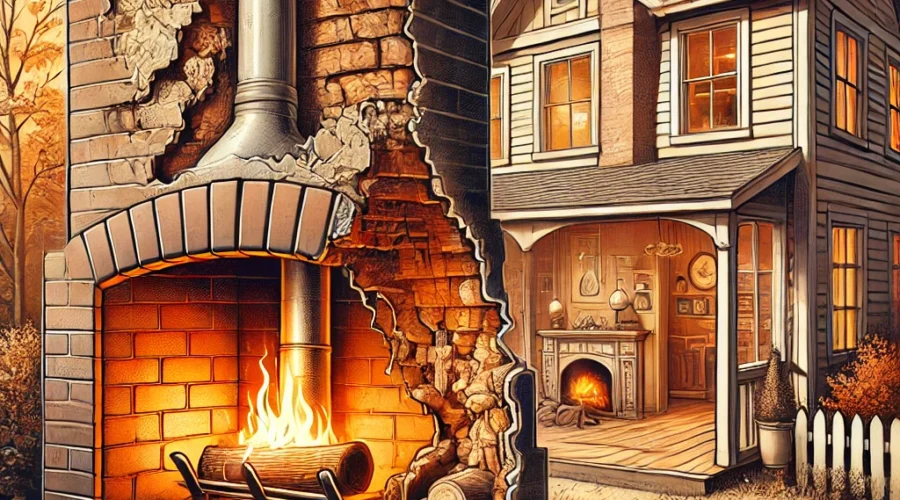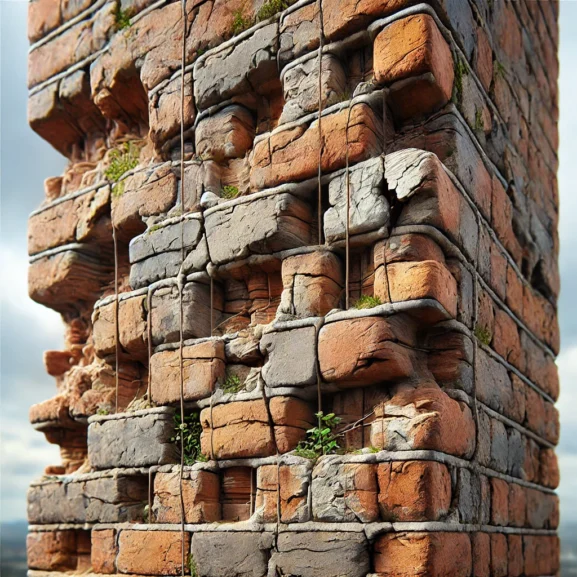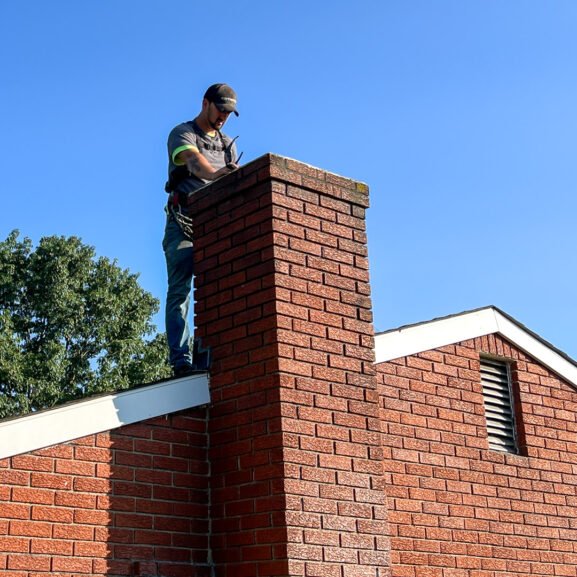Understanding Shaling of Chimney Liners in Older Homes: Risks, Signs, and Solutions
We’ve all heard the creaks and groans of an older home settling. But another hidden issue can occur: the shaling of chimney liners. As homes get older, the chimney liner can start to break down. Pieces may start to fall off. This process is called shaling. It might seem harmless at first, but it can cause serious damage. It can affect both the structure and safety of the home.
Knowing the causes and signs of shaling can help us protect our homes from harm. In this text, we’ll explore why older chimney liners are prone to this issue and what steps we can take to address it. We can ensure our homes remain safe and sound for years by staying informed. Let’s jump into the world of chimney maintenance and discover how to keep our chimneys in top shape.
Everything You Need to Know About Shaling in Chimney Liners
Shaling may seem small, but it can lead to big problems in older chimneys. It happens when the chimney liner starts to deteriorate and shed layers, which can cause the liner to crack. Over time, debris can fall into the fireplace, blocking the exhaust paths and creating unsafe conditions.
Climate wet winters and humid summers, is not so kind to masonry chimneys. Moisture seeps into the masonry, leading to liner damage. It might sound funny to have a little “chimney dandruff,” but it’s important to fix these masonry issues. If not addressed, they can get worse.
Signs of shaling include:
- Thin flakes of liner material at the base of the chimney
- Cracked chimney liners becoming visible
- Decreased draft efficiency or smoke backflow into rooms
Ignoring these symptoms may necessitate costly liner replacement. If you see signs of shaling, reach out to certified professionals for a consultation. We’re experts, not magicians, so let’s avoid the DIY rabbit hole. Check out the Chimney Safety Institute of America and the National Fire Protection Association for more on fire safety. Stay informed, stay safe, and keep your chimneys clear.
Causes of Shaling in Older Homes
Chimney liner shaling can become a pesky problem in aging homes. Understanding the causes helps in tackling it effectively. Let’s jump into the factors responsible for this common issue.
Material Degradation
Old chimney problems often stem from material degradation. Over time, chimney liners, particularly clay ones, crack and spall due to heat exposure. Picture them turning brittle, much like trying to bend flimsy plastic. Common signs of wear and tear on liners are thin flakes or pieces at the base of the chimney. These flakes show that the liner is no longer strong. The constant heating and cooling cause expansion and contraction. This process weakens our aging chimney systems even more. It’s like putting your favorite jeans in the dryer one too many times. Eventually, they just don’t fit right. When these issues arise, consulting experts for liner replacement becomes crucial. For professional guidance, reach out to certified professionals.
Environmental Factors
Environmental factors significantly impact deteriorating chimney liners. Wet winters and humid summers expedite the process. Moisture seeps into existing cracks and freezes, causing the masonry chimney issues to worsen with each thaw. This natural freeze-thaw cycle is a relentless adversary for our brick-and-mortar structures. Also, pollutants in the air contribute to chimney liner damage by corroding materials over time. Think of it as your chimney getting a little too intimate with the neighborhood smoke stacks. Keeping gutters clear and ensuring proper ventilation helps mitigate these effects. Always prioritize safety and call professionals for chimney inspections. For more information on chimney safety, visit Chimney Safety Institute of America or National Fire Protection Association.
Identifying Signs of Shaling

Chimney liner shaling in older homes can seriously impact safety. It’s essential to recognize the signs early to prevent damage.
Visual Indicators
Spotting shaling involves looking for clues in and around your fireplace. Flakes or thin fragments at the chimney base? That’s shaling’s calling card. Check the hearth for debris after using the fireplace. These fallen pieces hint at deteriorating chimney liners. Inspect the chimney exterior for visible cracks or discoloration in the masonry. If smoke escapes, it might not just be your cooking skills. Reach out to certified professionals for consultation. We leave the DIY mysteries to others and recommend consulting professionals instead. You can always rely on trusted sources like the Chimney Safety Institute of America for detailed insights.
Structural Implications
Cracked chimney liners can lead to more than unpleasant drafts. Shaling compromises the structural integrity of aging chimney systems. It limits draft efficiency, causing smoke backflow. This issue might sound like a magician’s trick, but it’s worse—it’s a fire hazard. The masonry chimney issues extend beyond just appearance, threatening both home and health. In fluctuating weather, with wet winters and humid summers, these problems worsen quickly. Regular inspections help address old chimney problems before they escalate. For more guidelines on chimney maintenance, the National Fire Protection Association’s website is an excellent resource. Consider our consultation services for maintaining a safe and efficient chimney system.
Risks Associated with Shaling
When chimney liner shaling occurs, it presents several risks that require attention. Ignoring the signs is like choosing to ignore a potential fire hazard. We promise our tone isn’t meant to scare you, but to educate.
Safety Hazards
Shaling leads to safety risks that are easier to address early. Debris from deteriorating chimney liners can block flue passages. Blocked flues increase the risk of carbon monoxide buildup, which is as fun as a surprise tax audit—avoid it! Shaling can also weaken the structure. This may lead to cracked chimney liners and unstable masonry. A weakened structure increases fire risks. Heat and gases can escape into vulnerable areas. Trust us, these aren’t the kinds of fireworks you want indoors. It’s crucial to call in the pros. The Chimney Safety Institute of America offers guidelines on keeping chimneys safe. Look out for shaling remnants, and for tips or help, reach out to certified professionals.
Air Quality Concerns
Shaling isn’t just a structural issue; it affects air quality too. Loose flakes and fragments can affect draft efficiency. This causes more smoke to drift back into your living spaces. No one wants an indoor bonfire! Dirty air from an old chimney can harm your lungs over time. An area’s tough climate makes it even worse. The wet winters put more strain on the liners. Addressing shaling early helps maintain clean indoor air. For quality assurance, source recommendations from the National Fire Protection Association. By keeping the air clean, you also keep Aunt Sally’s sneezes under control when she visits! Want advice tailored for you? reach out to certified professionals for top-notch service and peace of mind.
Repair and Maintenance Solutions

Our team offers top-notch repair and maintenance solutions for shaling chimney liners. Let’s explore how professional assessment and repair techniques address these issues.
Professional Assessment
A professional assessment identifies chimney liner damage in its early stages. Experienced inspectors detect cracked chimney liners and signs of wear and tear on liners. Our specialists evaluate masonry chimney issues to pinpoint exact problems.
- Inspections involve visual checks and camera probes
- Root causes like material degradation and external factors are identified
- Comprehensive reports outline next steps
Considering unique climate challenges, such as wet winters and humid summers, our evaluations are tailored to local conditions. Reach out to certified professionals for a free consultation with our expert team.
For additional tips and safety guidelines, explore resources from the Chimney Safety Institute of America or the National Fire Protection Association.
Repair Techniques
Efficient repair techniques restore aging chimney systems to functional and safe operation. Our team addresses liner replacement with expertise and care.
- Removing deteriorating liners and installing durable replacements
- Using heat-resistant materials to prevent future damage
- Masonry repairs to reinforce structural integrity
We don’t advise DIY approaches to fixing these issues, as professional repairs ensure top results. Remember, attempting your own fix could lead to laughs at our next meeting, but why risk it? Our specialists are ready to handle the job efficiently.
Reach out to certified professionals for a free consultation and ensure your chimney remains in perfect condition.
Preventing Future Shaling
To keep chimney liner shaling at bay, regular care is key. Cracked liners and aging chimney systems deserve continuous attention to extend their life without it feeling like they’re in a black-and-white movie.
Regular Maintenance
Regular maintenance tops the list for keeping shaling away from our chimneys. It’s crucial to schedule inspections twice a year. This helps catch deteriorating liners before they throw a house party with debris.
- Seasonal Checks: Inspect after winter and summer. These months take the most toll on liners due to weather changes.
- Cleaning: Soot and creosote buildup doesn’t only stain—it eats away at liners. Regular cleaning ensures safe exhaust paths.
- Professional Inspections: Only trained eyes can detect early signs of damage thoroughly. Reach out to certified professionals for consultation or expert advice.
For more on chimney maintenance (without the headaches), check this reputable guide from CSIA.
Material Upgrades
Sometimes treating old chimneys involves the “out with the old, in with the new” strategy. Upgrading materials secures aging systems against wear and tear on liners.
- Modern Liners: Consider steel or aluminum liners. They better resist heat and cracks than old clay ones.
- Waterproofing Treatments: Protect liners from moisture—keep cracks from shaling.
- Masonry Repairs: Strengthen the structure with attention to damaged bricks and mortar before they plot an escape.
We encourage anyone feeling the age of their chimney to explore upgrades for added peace of mind. For more tips, check NFPA’s chimney safety guidelines.
Conclusion
Addressing shaling in chimney liners is important for keeping our homes safe. It helps maintain the structure and integrity of older homes. By understanding the causes of shaling, we can prevent costly repairs. We can also avoid dangerous situations. Recognizing the signs early helps protect our homes. Regular inspections and professional assessments help us spot damage early. This allows for timely repairs. Upgrading to modern materials can protect our chimneys from wear and tear. Waterproofing can also prevent further damage. Let’s make our home’s safety a priority. Staying informed and getting expert advice when needed is key. Keeping our chimneys in good shape protects our property. It also helps improve air quality. Plus, it gives us peace of mind.
Frequently Asked Questions
What is shaling in chimney liners?
Shaling refers to the flaking or breaking away of material from chimney liners, commonly observed in older homes. It occurs as liners deteriorate due to factors like heat exposure, environmental conditions, and material degradation. This process can lead to hazards such as blocked exhaust paths and compromised chimney structure, posing safety risks.
What causes shaling in older chimneys?
Shaling is primarily caused by the degradation of materials, especially in clay liners. Heat, moisture from wet winters and humid summers, and air pollutants contribute to the weakening and cracking of liners, which then flake off over time.
How can I identify signs of shaling in my chimney?
Signs of shaling include visible cracks in the chimney liner, flakes or fragments at the chimney base, reduced draft efficiency, and smoke backflow into rooms. Regular inspections help in early detection and prevention of extensive damage.
Why is shaling dangerous for my home?
Shaling poses risks such as blocked flue passages, which can lead to carbon monoxide buildup and increase fire hazards. It also affects indoor air quality, potentially causing respiratory issues due to smoke entering living spaces.
What steps can I take to prevent shaling?
Prevent shaling by scheduling regular chimney inspections and maintenance, ideally twice a year. Regular cleaning to remove soot and creosote buildup is crucial. Upgrading to modern liner materials like steel or aluminum and applying waterproofing treatments strengthens chimney systems.
Should I attempt to repair shaling myself?
It’s advised against DIY repairs for shaling. Professional evaluation ensures accurate damage assessment and optimal repair solutions. Experts use advanced techniques, like camera probes, to inspect and recommend durable repair options that suit specific climate challenges.
How often should I have my chimney inspected for shaling?
To maintain safety and chimney integrity, inspect chimneys twice a year, after winter and summer. Regular inspection helps catch and repair any liner deterioration early, preventing further damage and maintaining optimal function.
Can shaling affect indoor air quality?
Yes, shaling can impact indoor air quality. As fragments disrupt draft efficiency, smoke might enter living spaces, possibly leading to respiratory issues. Prompt action and regular maintenance help maintain clean air indoors.
Are modern liner materials better for preventing shaling?
Modern materials like steel or aluminum are more effective in preventing shaling compared to traditional clay liners. They resist heat and cracking better, ensuring longer-lasting protection and reducing the risk of deterioration.


